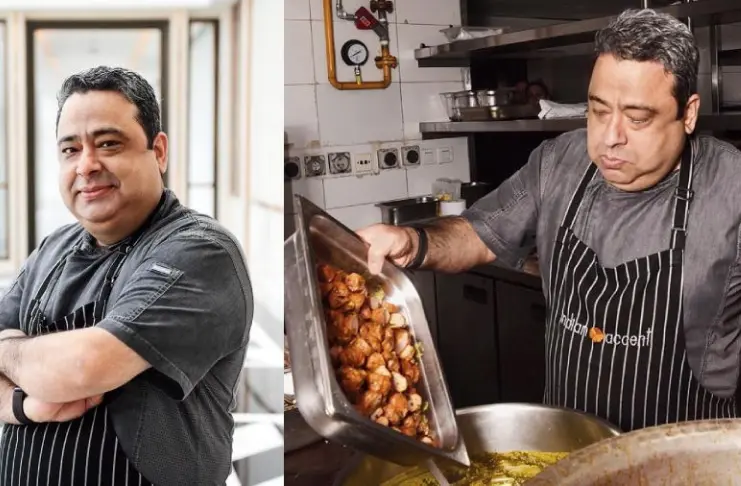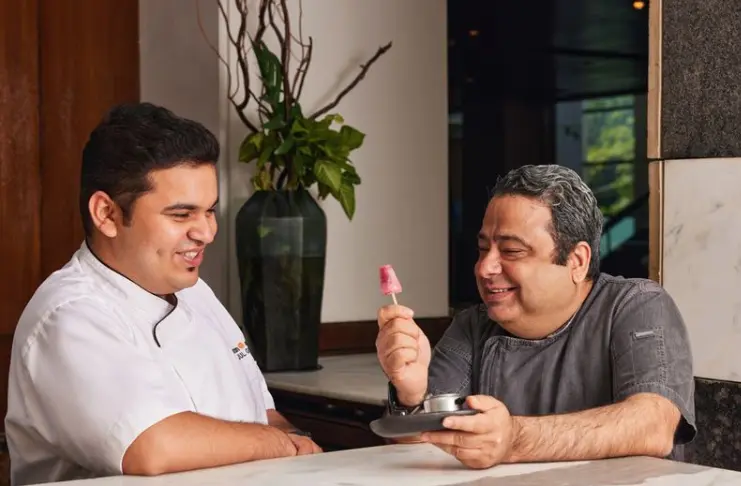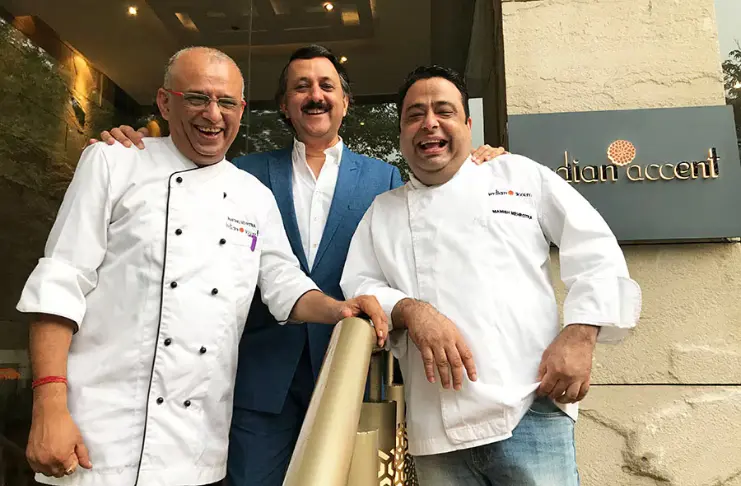You don’t go to Indian Accent because it’s famous. You go because you’ve grown tired of food being boxed in by nostalgia, tradition, and the weight of its history.
And that’s exactly what Indian Accent liberates you from.
Walk into its quiet, amber-lit space in The Lodhi, and you’ll instantly feel that this restaurant is not trying to impress you. It’s trying to reconnect you. Not to childhood dishes or five-star pomp but to the feeling that food can still surprise you, move you, and say something new.
A Quiet Culinary Revolution
In the world of Indian cuisine, revolutions rarely happen overnight. They simmer slowly, building flavor and complexity before revealing themselves fully. Such has been the case with Indian Accent, the restaurant that has fundamentally altered how the world perceives Indian dining culture.
When Chef Manish Mehrotra first introduced his blue cheese naan in 2009, few recognized it as the opening salvo in what would become a culinary movement. The dish itself seemed deceptively simple: tandoor-baked bread stuffed with imported cheese.
Yet that singular creation encapsulated everything Indian Accent would come to represent: tradition in conversation with innovation, local techniques embracing global ingredients, and above all, deliciousness that transcends cultural boundaries.
“It’s nothing modern as such. It’s just an upgrade,” Mehrotra explained in a recent interview. “If you call unique combinations modern, then it is modern. For example, if I do a mutton curry where oil is not floating on top, it is modern. It’s basically about getting the flavor, texture, and feel of the dish.”
This straightforward philosophy has guided Indian Accent to international acclaim.
Respecting Culinary Heritage and Making Indian Food Accessible

Unlike many chefs who chase fusion for its own sake, Mehrotra approaches his craft with deep respect for India’s food traditions.
“We don’t have to invent dishes,” he notes. “India has such rich cuisines and culinary history and heritage that all that we need is already here; we just have to dig it out, polish it, and present it.”
Mehrotra’s journey to create this distinctive approach came from seeing how other world cuisines had found global acceptance.
“When I traveled the world, I saw how the rest of the cuisines were presented in an acceptable manner,” he explains. “Gore ko hamare khane se darr lagta hai (Non-Indians are scared of our food). They’re scared because our recipes are intricate and so detailed. You’ve got to make your cuisine less intimidating and more relatable.”
He points to how Chinese food and Italian pizza have been adapted worldwide. “Look at Chinese food; they’ve made their cuisine so simplified that today everyone in the world knows and eats it, even if not in its authentic form,” Mehrotra observes. This realization drove him to make Indian cuisine “so comfortable that people aren’t afraid of trying to make it or eat it.”
Beyond Authenticity
One of the most refreshing aspects of Mehrotra’s approach is his rejection of rigid authenticity.
“I don’t understand the term authenticity,” he states firmly. “There’s no such thing as specifically authentic. You can’t find an authentic recipe, so going into that debate is pointless.”
Instead, Mehrotra focuses on a simpler rule: Food should be tasty no matter what you’re cooking or how you’re making it.
This commitment to flavor, above all else, defines the Indian Accent experience. While Mehrotra doesn’t mix cuisines in a single dish, he freely incorporates “different combinations of ingredients” to create memorable flavors.
From Delhi to the World
Indian Accent’s journey from its Delhi origins to international acclaim mirrors the evolution of Indian dining globally. What began at The Manor in New Delhi now includes locations in New York and London, each maintaining the restaurant’s core philosophy while adapting to local tastes.
“Delhi palate is evolving, and New York’s has already evolved,” Mehrotra observes. “Cities such as New York, London, and Melbourne are super cosmopolitan, and you get all sorts of evolved and finely tuned cuisines. Delhi and Bombay are slowly evolving.”
This understanding of different markets has helped Indian Accent succeed in areas where many other restaurants have failed. Rather than watering down flavors for international audiences, the restaurant offers the same commitment to taste and quality across all locations.
The Complete Experience
Beyond the food itself, Indian Accent offers a full sensory experience. The restaurant’s design avoids tired stereotypes of Indian restaurants. No sitars play in the background, and no heavy-handed decor tries to convince you of its “Indianness.”
Instead, diners find elegant simplicity – soft lighting that complements both the food and the conversation, comfortable seating that encourages lingering, and service that strikes the perfect balance between attentiveness and restraint.
The wine program deserves special mention for challenging the outdated notion that Indian food cannot pair with fine wines. From aromatic whites that complement lighter dishes to reds that stand up to intense curries, the beverage options enhance the overall experience.
Sweet Innovations

Indian Accent’s dessert menu perhaps best demonstrates Mehrotra’s talent for innovation. Traditional Indian sweets can challenge uninitiated palates with their intense sweetness and unfamiliar textures. Rather than abandoning these traditions, Indian Accent finds clever ways to present them.
The Doda barfi treacle tart transforms a sweet Punjabi fudge into a sophisticated dessert recognizable to international diners. The mishti doi cannoli presents Bengali sweet yogurt in a familiar Italian pastry form. Each creation builds a bridge between cultures without compromising either.
More Than a Meal
What makes Indian Accent truly special goes beyond its innovative dishes or prestigious locations. The restaurant offers something more profound: a new way of seeing Indian cuisine not as something fixed and unchanging but as a living tradition capable of growth and evolution.
When diners leave Indian Accent, they carry away more than memories of exceptional flavors. They take with them a new perspective on what Indian food can be—respectful of its past but unafraid of its future.
Before Indian Accent, many saw fine dining and Indian food as separate categories. After the Indian Accent, that false divide has been permanently bridged. In this lies the restaurant’s greatest achievement – changing perceptions of Indian cuisine both globally and within India itself.
And that, ultimately, is why you go to Indian Accent. Not for the awards or acclaim but for food that matters, food that moves you, food that reminds you why we gather around tables in the first place: to share something authentic, something surprising, and something genuinely delicious.





